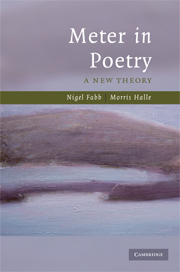6 - Greek
Published online by Cambridge University Press: 06 July 2010
Summary
Introduction
In his thorough and detailed account of Greek metrical verse, West (1982: 28) describes the range of meters by saying that ‘it is doubtful whether a coherent system could be devised, even if the world wanted it. Greek metre itself is too complex and multiform’. In this chapter we respond to this challenge by showing that Greek meters can all be explained using the theoretical machinery developed in the first few chapters of this book. We select some of the most widely used meters and discuss them in three groups. In section 6.2 we look at iambs, trochees, and cretics, and show that they must be analyzed as strict meters. In section 6.3 we show that dactylic hexameter and anapaests are loose variants of trochaic and iambic meters, with a non-iterative parenthesis insertion rule. In section 6.4 we show that a selection of the aeolic meters are strict (iambic) meters.
All kinds of meter involve counting and patterning. In the theory of this book, the counting explains the patterning: for example, by grouping the syllables of an iambic line into right-headed pairs we explain why every second syllable is marked. Greek verse is in quantitative meters, which are based on the distinction between light and heavy syllables.
The Greek meters contrast in this respect with the meters discussed in the preceding chapters, which divide the syllables into two classes on the basis of word stress.
- Type
- Chapter
- Information
- Meter in PoetryA New Theory, pp. 153 - 185Publisher: Cambridge University PressPrint publication year: 2008

